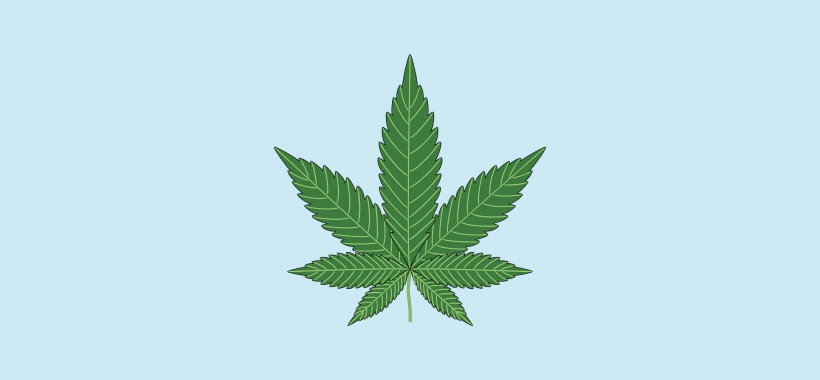In the past year, there has been a significant rise of the CBD-containing cosmetic products, as well as other cannabis derived ingredients, such as cannabis sativa seed (hemp) oil. CBD has become one of the most popular new cosmetic ingredients, which lead to an abundance of CBD cosmetics – from oils, serums, creams to even mascaras.
Cannabis plant and the difference between CBD and THC
Cannabis plant contains over 80 cannabinoids. By far the most known and investigated cannabinoid is tetrahydrocannabinol (THC), which produces a psychoactive effect. The second most important cannabinoid is cannabidiol (CBD), which unlike THC, has no psychoactive effect and is known to counteract the effects of THC and to have potential therapeutic effects. THC is found primarily in Cannabis indica (marijuana), while CBD is extracted from Cannabis sativa (hemp).
Cannabis sativa seed oil
Cannabis sativa seed oil or hemp (seed) oil is another popular cannabis derived ingredient for use in cosmetic products. Unlike the CBD, the cannabis sativa seed oil has been around for quite some time. It is extracted from the seeds of Cannabis sativa (often referred to as Industrial hemp), which contain low amounts of CBD and THC.
EU regulation
In EU, it is legal to cultivate and supply Cannabis sativa (Industrial hemp) plant for industrial uses such as hemp fibre and oil, provided that the THC levels in the plant do not exceed 0.2 %.
Cannabis sativa seed oil
Cannabis sativa seed oil, which is expressed from the seeds of Cannabis sativa, is allowed for use in cosmetics, providing that the level of THC does not exceed 0.2 %. In addition, also other cannabis ingredients, which are obtained from the seeds of Cannabis sativa plant, are allowed for use in cosmetics. Those include Cannabis sativa stem powder, seedcake powder, seedcake, seed water and seed extract. They can all be found in the EU Cosmetic ingredient database (Cosing).
Cannabidiol
CosIng includes two entries for Cannabidiol:
- Cannabidiol – derived from extract or tincture or resin of Cannabis
Cannabidiol, which is prepared as an extract or tincture or resin of Cannabis, is not allowed for use in cosmetics. This is in accordance with the Single Convention on Narcotic Drugs. It can be found in Annex II of Regulation (EC) No 1223/2009 on cosmetics products.
However, natural CBD is allowed for use in cosmetics if it is obtained from cannabis, cannabis resin, cannabis extracts and cannabis tinctures originating from seeds and leaves that are not accompanied with the fruiting tops of the cannabis plant and if the level of THC does not exceed 0.2 %.
- Cannabidiol – synthetically produced
Cannabidiol, which is produced synthetically, is allowed for use in cosmetic products.
US regulation
In 2018, the US has accepted the Farm Bill, which regulates production and marketing of hemp. The latter is defined as ‘’ the plant Cannabis sativa L. and any part of that plant, including the seeds thereof and all derivatives, extracts, cannabinoids, isomers, acids, salts, and salts of isomers, whether growing or not, with a delta-9 tetrahydrocannabinol concentration of not more than 0.3 percent on a dry weight basis\” (2018 Farm Bill). According to this new law, cannabis plants and its derivatives that contain 0.3 % or less of THC, are no longer controlled substances.
Cannabis ingredients, that fall under the definition of hemp as defined in 2018 Farm Bill, can be used in cosmetic products. However, it is important to note, that the product should not be adulterated or misbranded in any way. It is important not to use claims, such as ‘’treat’’, ‘’cure’’ or ‘’prevent disease’’, which would make the product a drug.
Canadian regulation
Canada has recently passed the Cannabis Act, which includes a broad definition of cannabis as ‘’any part of cannabis plant, including the phytocannabinoids produced by, or found in, such a plant, regardless of whether that part has been processed or not; any substance or mixture of substances that contains or has on it any part of such a plant as well as any substance that is identical to any phytocannabinoid produced by, or found in, such a plant, regardless of how the substance was obtained‘’.
Cannabis, as defined above, is listed on Health Canada’s Cosmetic Ingredient Hostlist of prohibited substances for use in cosmetics. The list also includes Tetrahydrocannabinol; delta-9-tetrahydrocannabinol; Cannabidiol; Cannabinol; Cannabis Sativa Flower Extract and Cannabis Sativa Flower/Leaf/Stem Extract.
However, there is also industrial hemp, which is exempted from Cannabis Act. Under Industrial Hemp Regulations, industrial hemp is defined as a cannabis plant or any part of the plant, that contains 0.3 % THC or less in the flowering heads and leaves. This also includes derivatives of industrial hemp plant, such as hemp seed oil.
Cannabis spp. (hemp) is included on the list of restricted substances for use in cosmetics (Cosmetic Ingredient Hotlist). This entry includes Cannabis sativa seed oil, Hemp seed oil and Hydrolyzed Hemp seed protein. However, these cosmetics must not contain an isolated or concentrated phytocannabinoid or a synthetic duplicate of that phytocannabinoid. In addition, a cosmetic product must not exceed the maximum allowed concentration of 10 µg/g THC (delta-9-tetrahydrocannabinol), as per the Industrial Hemp Regulations.
| Substance | Europe | Canada | USA |
| Tetrahydrocannabinol | Prohibited for use in cosmetics
|
Prohibited for use in cosmetics |
Allowed for use in cosmetics if the ingredients contain 0.3 % or less of THC (if they fall under the definition of hemp as defined in 2018 Farm Bill) |
| Delta-9-tetrahydrocannabinol | Prohibited for use in cosmetics
| ||
| Cannabidiol | – Prohibited If derived from extract or tincture or resin of Cannabis – Allowed for use if synthetically produced – Allowed for use if obtained from cannabis, cannabis resin, cannabis extracts and cannabis tinctures originating from seeds and leaves that are not accompanied with the fruiting tops of the cannabis plant and if the level of THC does not exceed 0.2 %. | ||
| Cannabinol | Prohibited for use in cosmetics
| ||
| Cannabis Sativa Flower Extract | Prohibited for use in cosmetics
| ||
| Cannabis Sativa Flower/Leaf/Stem Extract | Prohibited for use in cosmetics
| ||
| Cannabis sativa seed oil |
Allowed for use in cosmetics (if THC does not exceed 0.2%) | Restricted for use in cosmetics: – Cosmetics must not contain an isolated or concentrated phytocannabinoid or a synthetic duplicate of that phytocannabinoid – Max 10 µg/g THC | |
| Hemp seed oil | |||
| Hydrolyzed Hemp seed protein |


